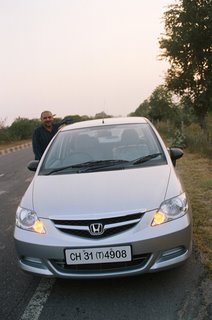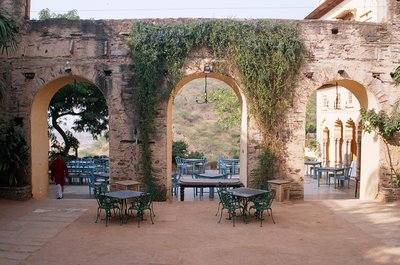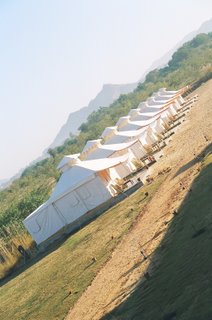TRAVEL JUNKIE
.......................
Nupur Amarnath heads for the caves at Ajanta

There’s something about the past. It's always glorious and it's always great. Since you haven’t lived in it, you never know the real truth. That is you never have a chance to dissect it and basically are at a loss of benchmarks to criticise it. And maybe, it’s all better this way. You know just living with the fact that it’s great and glorious because then you can revel in it. You are spared the dark side because it has happened and it hasn’t happened in your life. You might say I’m getting lost with this whole argument. I have a point. But the point is am I getting to it? This is the realisation that was only strengthened after my recent (with 2007 starting, I wonder how recent) trip to Ajanta caves.
Always a sucker for all things historical, Ajanta has been on my mind right from the time I first saw the one picture coyly avoiding my gaze from the yellowed dog-eared hand-me- down NCERT textbook. And sure as hell, that was the first painting I looked out for in the caves. And as is my habit, be very sure that the Ajanta trip is going to be all about me. Ajanta has been on my mind ever since my sister and friend moved into the vicinity. So one fine weekend (weekend warrior, moi) I booked myself on the train to Aurangabad at Nashik and landed at my friend’s and literally bulldozed him into going to Ajanta.
Deciding to set out bright and early, we were en route to Ajanta with driver Zafar and a treasure trove of songs that obviously I bellowed to my heart’s content. My rendezvous with Buddha (my idol escapist) and history was on road. After many bad renditions of songs happy and sad, we reached the complex where you park your car and board an AC bus (yes, we love our comforts). When an adivasi woman with nothing but a sari on, and nose rings the size of a mullet, got on to the bus, I knew history had started. As the woman made as many guttural noises as the bus, we were at the hub. But not ready to begin the tour just yet as before the mind is fed, the stomach needs to be fed up. After eating bad aalu-paranthas (an insult to the North-Indian in me), we finally climbed the stairs to the world heritage site and Rs 75 gave us our entry into the past.
After much haggling with and over the fact whether we wanted a guide, we decided to try exploring the caves on our own. Considering the entire way was well done up with stairs and pathways, we really felt a guide would be unnecessary. There from the walls of the first cave was my picture _ my handsome prince from the history book still avoiding my gaze. But sure enough, it was him and I was again a student of Class X reading up on the glorious Ajanta, only this time I was there.
At the second cave, we ran into Johnny Bhai. A cut above the rest, JB was hired for Rs 300: a little for our knowledge and a lot for our amusement. As he began his first discourse on the carved figures by referring to the veena as the guitar, “Veena aapki bhasha main kehte hain, guitar hamari language main!” we knew JB was the right choice. Making sure that he would click us at all the places he thinks are picturesque, we were left wondering whether he’s a guide or a photographer. Making points with us by referring to us as his kids, the 67-year-old has literally grown up in the caves. And what a place to grow up!
To say that Ajanta awed me is not even necessary. As I walked through cave after cave with literally dropping jaw was proof enough. Yes, man’s tenacity and perseverance simply leaps at you from the caves. As much as the fact about man’s intrusion. I mean if you ask me, why not just let the mountains be? But just as we have a tendency to leave our mark somewhere, even the moon is not spared, so do the people in the olden times. The caves are daunting at the least and they really make you feel small in the light of human effort. Maybe, it’s just as well some person woke up one day and picked up his chisel and decided to take a go at the mountains. I mean, would I have gone visiting had somebody not done something this spectacular? Isn’t it that if you have seen one mountain you’ve seen them all? Probably, that’s me being cynical. But Ajanta was a trip back to the time when resources were few but enterprise was immense.
Clearly, I can’t say what are the lessons learnt or even if I had gone to learn some lessons. But looking and remembering the time when my voice was echoing in the caves, I was transported into a world where the disciples of Buddha would get together and chant. You can feel the history. It’s there in the stones, in the colours and in the carvings. And as you get ready to leave, it’s there in you.
WHAT THE MIND REMEMBERS

The inkwells: Each cave had these ‘little’ (in comparison to the whole cave) inkwells where the painters would pour the colours to paint. Even after all these years, the colour hasn’t quite worn off and green is still green and red is red. Hell, you can’t even say the same thing about most of the modern-day glossies.
The roofs: I never expected to see rock to be so dynamic. Hats off to the artisans of Ajanta who managed to give a 3-D effect to the roofs. Carved in shamiana style, the rock of the roofs actually seemed to be moving in wind. How did they manage that? And the best bit, you may miss that if you are standing in the middle of the room. You have to see the roof from the side to feel its dynamism. It is magical.
The tales: For most like us who have grown up on the staple diet of Amar Chitra Kathas, you may be able to recognise and identify some familiar jataka tales. From the story of the four tusked white elephant to the story of the king and the jackal, the walls of Ajanta are well worth a read. And it’s even more fun to hear it from your guide who recites in a sing-song fashion, very reminiscent of the peddlers of the local buses, which I don’t know whether frequenters of Weekend Warrior are familiar with. Obviously, I’m considering them to be the high-end-big-spender-big-car demographic! Which makes me wonder what am I doing writing a piece for it!
The pillars: You’ve to give it to the wily craftsmen of yore. They really knew how to turn a phrase in stone. When they talk about all the pillars of the society, the craftsmen have actually hewn figures supporting the pillars from the sadhu to the couple to the errant couple to the king, they are shown supporting a pillar each. Interesting!
The Buddha: Besides Shiva, I always thought Buddha was the handsomest Indian God. Or maybe after years of seeing him depicted in more than flattering tones in Amar Chitra Katha and his carvings at Ajanta now, my ardour for him has only gone up. This coupled with the fact that you just can’t have him, not because he’s dead, but also because he was a celibate (why do you think Amrapali fell for him) only helps to make Buddha all the more desirable. So seeing him cave after cave is actually a site for sore eyes. Little wonder there are more takers of the Hinayana cult (where they worship his imagery) than the Mahayana!
The spine: One of the two Mahayana caves in Ajanta has a mixture of Mahayana and Hinayana sects through sculpture. The interesting fact is the spinal design on the roof. Since the Buddhists worship through meditation and the spine is the crux of the kundalini, you could feel it undulating on you from the top. A little gory for my taste as it reminded me of a scene from Hannibal where Ralph (pronounced Rafe) Fiennes moves the dragon tattoo on his back in a most grotesque fashion. Couldn’t have been very peaceful, I would say!
(The writer, Nupur, may not be a die-hard Weekend Warrior, but she won't miss a chance to hit the road! Hell, she even considered auditioning for MTV Roadies! Better sense prevailed, and she decided to jump on the Nashik Road-Aurangabad train instead.)
























